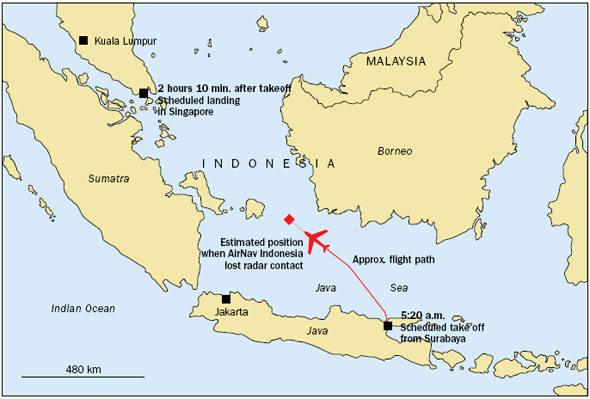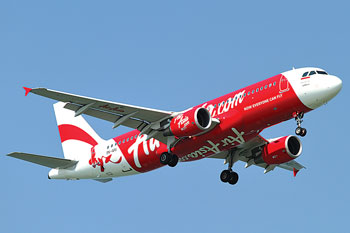INDIAN ARMED FORCES CHIEFS ON
OUR RELENTLESS AND FOCUSED PUBLISHING EFFORTS

SP Guide Publications puts forth a well compiled articulation of issues, pursuits and accomplishments of the Indian Army, over the years

I am confident that SP Guide Publications would continue to inform, inspire and influence.

My compliments to SP Guide Publications for informative and credible reportage on contemporary aerospace issues over the past six decades.
The AirAsia Disaster
 |
By Air Marshal B.K. Pandey (Retd) Former Air Officer Commanding-in-Chief of Training Command, Indian Air Force |
In all probability, the pilot of Flight QZ8501 too has blundered into a violent thunderstorm and lost control of the aircraft

The year 2014 has indeed been a year of airline disasters and especially for South East Asian carriers. The first tragedy that struck was with Malaysia Airlines flight MH-370 that went missing on March 8 while flying from Kuala Lumpur to Beijing. The aircraft involved was a Boeing 777-200 ER and was carrying a crew of 12 members and 227 passengers from 15 nations. The last voice contact with Air Traffic Control was less than an hour after take-off when it was over the South China Sea. For some strange reason that remains unexplained so far, there was significant deviation from the flight path as instead of heading north, the aircraft was observed to be heading in the opposite direction and is believed to have reached in the vicinity of the Maldives and Diego Garcia. The other intriguing aspect was that there was no communication from the crew, either through voice or automated transmission, indicating distress of any kind, bad weather or any technical issues with the aircraft. There have been a number of scenarios painted by different agencies and experts to explain the mystery of its disappearance without trace. These have been ranging from hijack to hypoxia. Theories have circulated delving into the possibility of terrorists forcibly taking over control of the airliner and crashing it into the Indian Ocean just to commit suicide. But perhaps the most bizarre explanation has been the recent hypothesis by Marc Dugain, the former CEO of a French Airline, suggesting that Flight MH-370 may have been shot down by the US military fearing a hijack of the aircraft and a September 11, 2001 (9/11) style attack on the American installations in Diego Garcia. However, until and unless the wreckage is located and the plane’s black box is recovered, the mystery behind the disappearance of Flight MH-370 will remain unsolved.
 A file photograph of AirAsia Airbus A320-200 aircraft
A file photograph of AirAsia Airbus A320-200 aircraftThe wreckage of the passenger plane however, was located soon after and every bit of the wreckage has been transported to Holland earlier this month by road to be reassembled for further investigation into how the airliner was destroyed. It is expected that the Dutch Safety Board may take several months to reassemble the aircraft from the wreckage and complete the investigation. One can expect a report not earlier than the middle of the new year or even later.
And now another airline disaster that struck South East Asia when an Airbus A320-200 aircraft belonging to AirAsia Indonesia operating as Flight QZ8501 went missing on the morning of December 28, 2014. The aircraft was operated by AirAsia Indonesia, a joint venture with AirAsia Berhad of Malaysia. AirAsia Indonesia has a fleet of 30 Airbus A320 aircraft.
On the fateful day, the aircraft was flying from Surabaya in Indonesia to Singapore with 162 persons on board. The total flight time was expected to be just over two hours. Apparently, the aircraft encountered severe thunderstorms en route and the pilot asked for permission to climb to a higher altitude so as to avoid entering the thunderclouds and instead to fly over them. The aircraft was permitted by the Air Traffic Control to climb from his cruising altitude of 32,000 feet to 38,000 feet which might not have been adequate to clear the top of the thunderclouds. It seems that thereafter, Flight QZ8501 lost contact with Air Traffic Control at 06:24 local time while flying over the Java Sea, 40 minutes after departure from Surabaya. There was no distress call nor any other transmission from the crew. The Captain of the aircraft was an Indonesian national with a total flying experience of more than 20,000 flight hours. Of these, he had logged around 6,100 flight hours on the Airbus A320 flying with AirAsia Indonesia. The first officer, a French national, had 2,275 flying hours to his credit. Experience levels of the pilots, therefore, is unlikely to be an issue in this accident.
This accident has an uncanny resemblance to the one in which Air France AF-447 was lost over the Atlantic Ocean in June 2009. The aircraft in this case was an Airbus A330 and was flying from Rio de Janeiro to Paris. All 228 souls on board perished in the disaster. In the case of AF-447 too, the pilot had encountered a wall of thunder clouds and attempted to climb over these. It is believed that while so doing, he encountered severe icing leading to loss of airspeed indications which ultimately resulted in loss of control over the aircraft. Should the pilot commit the fateful error of entering a thunderstorm, he might well lose control of the aircraft. Regaining control of the aircraft inside a thunderstorm will be an extremely difficult proposition if not an impossible one. Also, the inside of a thunderstorm can be turbulent enough to cause structural damage to the aircraft which can only aggravate the situation. In the case of AF-447, it took nine months for the wreckage to be recovered from the bottom of the Atlantic Ocean and two years for the plane’s black box to be found.
Latest reports are that the parts of the ill-fated airliner and bodies have been found floating close to the area where the aircraft lost contact with the ATC. As the Java Sea is only around 40 metres deep in the area, it may not take long to recover the wreckage. At this point in time, it appears that in all probability, the pilot of Flight QZ8501 too has blundered into a violent thunderstorm and lost control of the aircraft. However, the final word can only be said if and when the Flight Data Recorder and the Cockpit Voice Recorder, components of the black box, are recovered and analysed. Till then, loss of Flight QZ8501 will remain as much of a mystery as those of Flights MH-370 and MH-17.





